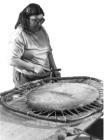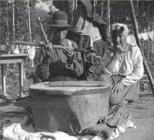1
Aboriginal people were ingenious, hardy individuals and were the first to inhabit the Red Lake area. Cree and Ojibway were the primary linguistic groups in the region and many of their ancestors still live here today.2
Early Aboriginals were familiar with the properties of the plants and wood and with the habits of wild animals. They lived off the land along the many waterways.Everything needed in their daily life was taken from the environment - tools were carved from stones, wood and the bones of animals; clothing was made from the hides of wildlife; and meat from those animals was taken for food, along with the plants and berries in the area. Nothing was wasted.
They treated their environment with respect and celebrated its bounties through their spirituality.
4
Ceremonial gatherings, known as Pow-Wows, were an important part of native culture. These were held at specified places and at certain times of the year so that people could come together from far-reaching areas.This is where family ties were renewed, courtships begun or completed, and tribal alliances strengthened. Marriages might be celebrated, children named, leaders chosen or honours awarded.
In Red Lake, Pow-Wows were traditionally held at various places, such as Kinsmen Beach at Forestry Point, Rahill Beach, and Sandy Point.
In the early 1900s, Chief Tom Paishk was one of the best known drummers and most respected elders. He passed on his knowledge to his son John, who continued the tradition until the middle of the century.
6
Spiritual beliefs play a major role in the lives of the Ojibway people, especially in their healing and preventative medical knowledge.Medicines were created mainly from plants in their environment. These remedies were considered a gift from the creator and were therefore sacred.
In Ojibway culture, women were considered life-givers and healers, while the men were the “medicine people,” who doctored the sick with medicines and spiritual ceremonies.
One such healer was Fairwind or Naaminwan. He was one of the most powerful medicine men in the Berens River area north of Red Lake. His ability to perform everyday miracles was legendary and people would travel from hundreds of miles to be healed by him.
According to legend, while grieving over the death of his favourite grandson, Fairwind was told in a vision to build a dream dance drum, which would guide the dead to the next life.
Fairwind and his descendants used the drum in the Poplar Hill and Paungassi area until the mid ’70s. Over the years, traditions like the drumming ceremony declined and the drum was no longer used.
Fairwind’s drum has since been donated to the Red Lake Museum and Aboriginal people who are going back to traditional ways come to pay their respects. Considered to have a life of its own, the drum is one of the Museum’s most prized artifact.
7
Preparing a beaver pelt at the Red Lake Trapper's Festival1990
Red Lake, Northwestern Ontario, Canada

8
Until the 1950s, trapping was the native man’s way of life. It was the principal occupation of most Native people in the area. Aside from a small number of men who went to work in the gold mines of Red Lake and Pickle Lake, virtually every male over the age of 16 was a licenced trapper.Over the last 20 years though, the animal rights movement has nearly destroyed the fur industry, severing the very lifeline of many of the First Nations people in the region. A lynx pelt that sold for $600 in the late ’70s, now sells for only $40. Trapping today is more of a hobby than a way of making a living.
10
One of the most noted dates in Native culture is October 3, 1893.After three years of negotiations, the Canadian Government and the Saulteaux (Ojibway) and Chippewa Indians signed Treaty Three, which encompassed much of what is today known as Northwestern Ontario.
Under the terms of the agreement, Native people were to surrender their lands to the Queen so that the government could proceed with the development of a railway and the harvesting of minerals and timber. In exchange, the Crown set aside certain areas for farming, schools were established, and fishing and farming supplies were provided to the bands.
The Ojibway of Northwestern Ontario proved to be highly skilled negotiators, obtaining additional terms not granted in previous treaties. Treaty Three was ground breaking and became a model for future agreements.
12
There are even celebrity figures in the Native community in this area, none more famous than Norval Morrisseau.In 1959, Norval, a young Ojibway man from Beardmore, Ontario, came to Red Lake to work in the gold mines. A self-taught artist with a grade three education, he began interpreting the legends of his people through his paintings.
“My aim is to reassemble the pieces of a once proud culture and to show the dignity and bravery of my people. The time has come for us all to write and to record the story of our people; not only for ourselves, but for our white brothers so that they will be able to understand and respect us,” Norval wrote.
He has experienced unprecedented fame as the founder of the Woodland Art movement. Red Lake was the launching pad for the artist, as well as the place from which he drew inspiration for his work - from the landscape and rock paintings surrounding the area.
Today, Norval is recognized as one of the most important Aboriginal artists of the century. Originals of his early works can be found in many homes in the area.



